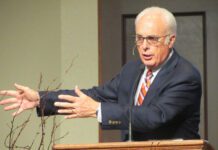It’s possible, say theatre people, for an audience to leave a performance humming the set. It means the scenery was better than the show, or certainly more memorable. Actors know that where a story is told can influence how or whether the story is heard. It’s true whether your story comes from Shakespeare or Solomon.
The Approach
“Going to the theatre” is as much about the going as it is about the theatre. Why else would people leave the comfort of their homes and massive television screens for relative discomfort and poorer sight lines? Those who come to your building for worship have made a similar choice. Much of the work of worship leaders is to lead worshipers from a preoccupation with the everyday to a preoccupation with God.
The best-designed venues for theatre and music do something similar. They seek to move audiences from the everyday to the inspiring, physically and mentally, by moving them through a series of distinctive aural and visual environments. From a chaotic street environment, visitors typically enter a still noisy, but better organized lobby. From the lobby, they pass through a nearly echoless soundlock on the way to the main space.
The contrast is dramatic and is accompanied by changes in geometry, light level and finishes. Everything conspires to tell people something special is ahead. By the time a ticket-buyer sits, he or she is ready to give full attention to the performance.
Even without such a sequence, buildings affect audiences before the speaker opens his or her mouth. Research done for the retail industry has shown that higher ceilings cause occupants to think loftier thoughts. Neuroscientists think the built environment can facilitate healing, shape our brains and literally transform our minds. Without help from the building, the burden of preparing the audience falls more heavily to the presenter.
The Room
Architecture, because of its finite nature, necessarily articulates priorities. When choosing how to spend dollars and space, churches subtly decide what matters most. Buildings are blabbermouths. Every decision is shared publicly. Great, ornamented cathedrals share one vision of God and His people. Humble boxes stripped of decoration say something else.
In the earliest churches, the placement of every feature communicated theological truth. A screen between congregation and altar separated the sacred from the profane. Placement of the lectern, from which the gospel was read, on the north side of Catholic churches remembers days when the most visible pagans lived on that side of Rome. The imagery used to decorate the space from where the Bible was read to an illiterate audience.
In newer churches, the nature and location of pulpit and aisles reflect our ideas about speaking and listening. The desire to have everyone, including musicians, under the Word can have physical implications. The decision as to whether the lectern is oak or acrylic — or is replaced by a coffee table — preaches its own sermon to speaker and hearer, as does the lack of a pulpit altogether.












